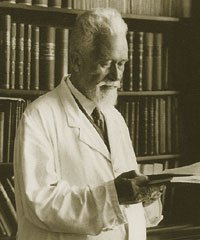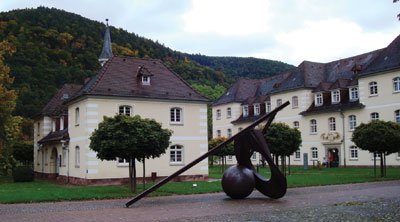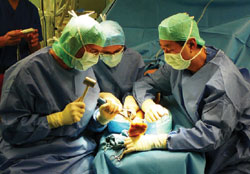Innovation, vision give rise to orthopaedic tradition at the University of Heidelberg
The Kirschner wire and Lindemann procedure were developed at the university’s orthopaedic clinic.

Heidelberg, Germany, has been recognized as a major world center for medicine for so long that by the time orthopaedic surgery and traumatology services were introduced there in the 1800s, the University of Heidelberg’s clinical, research and educational traditions had already been established for a few hundred years.
The initial efforts at practicing orthopaedic surgery in the city occurred in the 1890s and were directed at addressing the musculoskeletal needs and deformities of the local population.
In 1918, Hans Ritter von Baeyer, MD, established the first orthopaedic clinic at the university — Stiftung Orthopädische Universitätsklinik Heidelberg. He became its first chairman.
Several developments have since come out of the university orthopaedic clinic to make it well known in musculoskeletal medicine, including the Kirschner wire and the Lindemann procedure to repair ACL tears, both named for Heidelberg physicians.
Orthopaedic tradition
|
Images: Wenz W |
“Heidelberg is one of the great places in Europe that was important for the evolution of orthopaedics throughout the world,” said Wolfhart Puhl, MD, a member of the Orthopaedics Today Europe Editorial Board and a past president of the European Federation of National Associations of Orthopaedics and Traumatology (EFORT). He was vice chairman of the university’s department of orthopaedic surgery from 1977 to 1984.
Like some other orthopaedic institutions established early in the last century, the emphasis in Heidelberg was on managing deformities in children, either congenital or from disease or injury.
First clinic
Oskar Vulpius’ name is usually the first one noted in connection with the history of orthopaedics in Heidelberg. His patients mainly consisted of children crippled from poliomyelitis, and he treated their paralyzed limbs with a tendon transfer technique that was considered innovative when he introduced it (surgeons later critiqued and improved the technique).
In 1893, Vulpius established an orthopaedic ambulance through the surgical department at the university clinic, the forerunner of the current orthopaedic department, said Felix Zeifang, MD, PhD, a consultant in the university’s orthopaedic department.
Vulpius, a lecturer for the university’s orthopaedic course, is known for his important early papers on tendon transfers to treat cerebral palsy, clubfoot, polio and other musculoskeletal conditions, according to Wolfram Wenz, MD, who heads the foot deformities unit and practices pediatric orthopaedics at the university hospital.
Von Baeyer succeeded Vulpius. He was department chairman until 1933.
|
|
“It should be remembered that Von Baeyer devised the bifurcation osteotomy for congenital hip dislocation in 1918. Translocation of tendons was another of his ingenious ideas — for example, the translocation of the flexor pollicis longus in paralysis of the thenar muscles,” Wenz told Orthopaedics Today Europe.
Martin Kirschner, MD, is also associated with orthopaedics in Heidelberg. His eponymous invention for facilitating osteosynthesis and guiding the placement of orthopaedic hardware is still used worldwide by orthopaedic surgeons. Kirschner published widely and contributed greatly to orthopaedic education, Wenz said.
Ernst Marquardt, MD, helped put Heidelberg on the map in the orthotics and prosthetics field.
“I admire them all for being pioneers,” Wenz added.
Foot deformity
The hospital’s early emphasis on clubfoot and other lower extremity and pediatric deformities led to the formation of a special unit for this work in 2003. “We treat these problems with probably the highest frequency in the world,” Wenz said.
“We want to offer the highest quality in pediatric orthopaedics and foot surgery. We have already developed some cutting-edge techniques for the most challenging foot deformities, such as calcaneus and cavo-varus foot.”
Lindemann technique
|
|
Kurt Lindemann, MD, chairman of the department from 1954 to 1966, was succeeded by H. Cotta, MD, who was chairman until 1996.
Around 1950, Lindemann described an ACL repair technique that involved detaching the semitendinosus from the tibia, rerouting it and the muscle belly through the popliteal space and the notch and fixing it with a suture wire in an anterior tibial tunnel.
In the 1970s, Cotta expanded the clinic considerably and encouraged department members to specialize. Such specialty areas emerged as joint replacement, spine and upper extremity, along with paraplegia, congenital and acquired deformity, and bone cancer treatments.
Orthopaedic innovation continues today under Volker Ewerbeck, MD, who became department chairman in 1996. Department members are testing a new prosthetic hand and researching paraplegia medicines that use antibodies.
More than 6,500 surgical procedures are performed annually at the 220-bed clinic.
For more information:
- Wolfhart Puhl, MD, professor and chairman of the Department of Special Orthopaedic Surgery at Klinik Oberstdorf, can be reached at Trettachstr. 16, DE-87561 Oberstdorf, Germany; +41-44-448-4400; e-mail: wolfhart.puhl@me.com.
- Wolfram Wenz, MD, can be reached in the Orthopaedic Department, University of Heidelberg, Schlierbacher Landstr. 200a, DE-69118 Heidelberg, Germany; +49-6221-966118; e-mail: wolfram.wenz@urz.uni-heidelberg.de.
- Felix Zeifang, MD, PhD, can be reached in the Orthopaedic Department, University of Heidelberg, Schlierbacher Landstr., DE-69118 Heidelberg, Germany; +49-6221-969201; e-mail: felix.zeifang@ok.uni-heidelberg.de.



